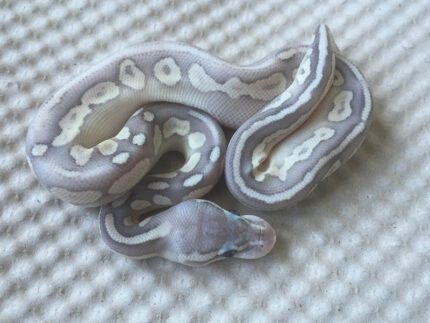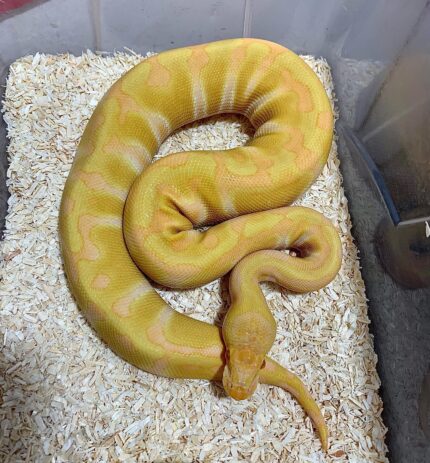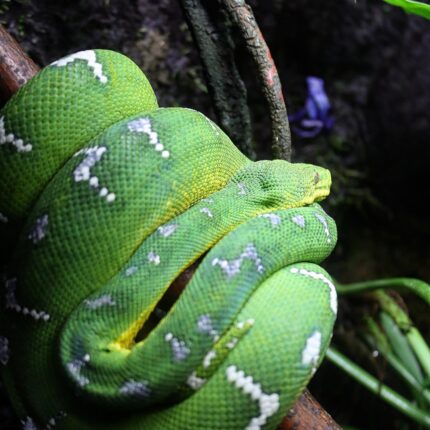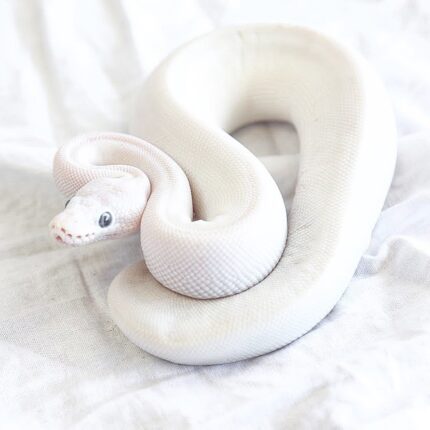Pastel Bamboo Ball Python, The bamboo ball python is a relatively new morph, which can make them more difficult to find than other ball pythons. Keep reading our guide to learn more about these snakes and whether they are a good fit for you and your family!
Quick Facts about the Bamboo Ball Python Morph
| Species Name: | Python regius |
| Common Name: | Royal python, ball python |
| Care Level: | Low |
| Lifespan: | 20-30 years |
| Adult Size: | 3-5 feet |
| Diet: | Primarily rodents |
| Minimum Tank Size: | 30-60 gallons |
| Temperature & Humidity: | 78° F to 95° F (basking spot), 40%-60% humidity |
Do Bamboo Ball Pythons Make Good Pets?
Like other ball pythons, the bamboo ball python can make a great pet, even for a beginner. While 3-5 feet may seem big, ball pythons are actually fairly small compared to other constricting snakes. Their small size in combination with their docile nature makes them easy to handle. Additionally, their tanks don’t need to be as big as other, larger species, which means they are appropriate for many different types of homes because they take up less space.
Appearance
Bamboo ball pythons are characterized by a pale belly contrasted by a dark green “bamboo” pattern on their backs. You can also find pastel bamboo ball pythons, which tend to be more vibrantly colored. As they get older, bamboo ball pythons will start to lose their coloring and may begin to develop brown spots.
How to Take Care of a Bamboo Ball Python
Habitat, Tank Conditions & Setup
Tank
Your bamboo ball python’s tank should be at least 30 to 40 gallons large. Of course, you can always buy a larger tank if you have the space; there is really no such thing as too big. Provide your snake with a shelter or some other place to hide in the tank. In terms of cleaning, you can spot clean the tank as needed. Plan to clean the tank in its entirety about once a month.
Lighting
While you do not need to provide UVB lighting for your bamboo ball python, you can still choose to include it in your snake’s tank. You should also add at least two heating lamps: one for the day and one for the night. These lights should be on a 12-hour cycle to simulate daylight.
Heating (Temperature & Humidity)
In addition to providing your snake with a place to bask, you should also make sure there is a “cool” area in the tank where it can go if it gets too hot. The basking area temperature should be about 95° F and the cool area should be around 78° F. In addition to heat, the tank needs to be moderately humid, between 40% and 60%.
Substrate
Ball pythons are not especially picky when it comes to substrate; as long as the substrate is relatively porous and can maintain a level of humidity in the tank, it will probably work. Some ball python owners prefer sphagnum moss, but aspen shavings will also do.
Tank Recommendations
| Tank Type | Minimum 30-gallon glass vivarium |
| Lighting | 2 bulbs on 12-hour timers |
| Heating | Heating pad under the tank, incandescent light bulbs |
| Best Substrate | Sphagnum moss or aspen bedding |
Feeding Your Bamboo Ball Python
You should cater the type and size of prey you feed your snake to his size. The prey should be about the size of the widest part of your snake, but no bigger. Hatchling and juvenile bamboo ball pythons can eat crickets and pinky mice, while adults can handle adult rats and mice.
You do not need to feed your snake every day. Aim to feed a young snake about every 5 to 6 days. Adults need to eat even less frequently, once every 10 days to once every 2 weeks.
Diet Summary
| Fruits | 0% of diet |
| Insects | 0% of diet (but some juveniles eat crickets) |
| Meat | 100% of diet – small/medium-sized rodents |
| Supplements Required | N/A |
Keeping Your Bamboo Ball Python Healthy
Even though you probably won’t be handling or interacting with your python as often as you would another kind of pet, it’s important to keep an eye on your snake to make sure it is healthy. Like all other animals, bamboo ball pythons are prone to certain health conditions that you need to be aware of. A healthy snake should have clear eyes and should shed and eat regularly. A snake that is experiencing a health issue might shed more often than usual, develop bumps on its skin, or seem reluctant to eat. Note that there are some perfectly normal reasons why a snake might not want to eat; for example, when a snake is about to molt, it may lose its appetite.
Below are some common health problems that your bamboo ball python could develop.












Reviews
There are no reviews yet.